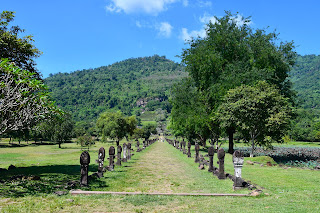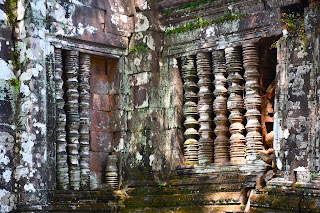Luang Prabang to Angkor – Day 7: Pakse
Since our hotel was a bit far from the centre of Pakse, we had to hail a cab that would take us to the street with all the motorcycle rentals. We found one right in front of our hotel: it was a motorcycle with a roofed carriage attached to the side, and the driver asked for fifty thousand. I doubted he would know the rental place I had in mind, so I told him to drop us off at a temple nearby; that way, we could take a few pictures and walk right over.
It just so
happened that the motorcycle rental I intended to visit was all booked out. It
had good reviews on Google Maps and seemed to be swarmed by tourists. I soon
discovered why: it was owned by a Frenchman, which is the reality of many
well-rated places on the internet. Foreign (usually European and frequently
French) owners bring the initial capital, foreign language skills, and internet
savviness to build a business that attracts other foreigners and diverts money
from ordinary Lao people. Doubtlessly many locals are employed by such
businesses, but it is unfortunate that much of the tourist revenue in Laos
seems to stay out of Lao pockets.
We ended up
renting a gleaming white motorcycle from a rental next door. This time, our
helmets had visors, and I remembered to break open my emergency facemask.
However, I soon found this had not been necessary. The roads around Pakse were
much better paved than the roads around Luang Prabang, and the air seemed far
less dusty. Also, the way to our destination was very flat in comparison to the
hilly countryside of Luang Prabang, which allowed me to break through my mental
barrier of going above fifty kilometres per hour. The sun shone brightly over
the rice fields full of farmers in their wide-brimmed paddy hats, and every
time I slowed down, I could feel my skin burning under my layer of sunscreen.
The buffalo clearly felt it as well. They all either had fresh mud on their
sides or congregated under the trees.
We arrived
at Vat Phou a little after ten o’clock in the morning. I thought this
was already somewhat late, but there were not too many tourists at the site.
Built into the side of the sharply rising mount Phou Khao, Vat Phou is a Khmer
temple with a long history. The first religious objects found at the site may
date to as early as the second century BCE; they include a carving of a
crocodile, which a sixth-century Chinese source claims was used for human
sacrifices. In the seventh century, a pre-Angkor building was added to the
complex, bust most other structures at Vat Phou were built between the eleventh
and thirteenth centuries, when the area was ruled by the Khmer Empire. The
location of the temple must have been seen as highly auspicious: the peak of
the mountain resembles a lingam, a symbol of Shiva, and a small stream gushes
from the rock near the upper reaches of the complex.
Nowadays, some parts of the temple ruins are used for
Buddhist worship and contain Buddhist statues. Many of the original Hindu
statues have been moved to a museum right across the lawn from the ticketing
area. When we were there, I wanted to look up a few things on my phone, but to
my horror I could not find it in my backpack. I realised I must have left it in
the open compartment under the handles of the motorcycle. Unable to think of
anything else, I rushed us through the museum until we got back to the bike: Fortunately,
it was still there.
We decided to get back to Pakse along a different road
from the road we took there. The navigation had originally sent us inland, but
I thought it would be nice to ride along the river and pass through the old
capital of Champasak. Google Maps really played a number on us, though, in
sending us down a “shortcut.” Initially, the dirt road was navigable, even if Barron
had to swerve past a few potholes here and there. However, the potholes soon
multiplied, and before we knew it, a bend in the road led us into a deep ditch.
I gasped “slow down!” but it was too late. We ran into the ditch, I got thrown
off, and the bike squeezed my right foot. All this happened very quickly, but
we were up again just as quickly to assess the damage to the bike. We could not
find any, though its pristine white coat was now splattered in mud.
As Barron lugged the bike out of the ditch, I went
ahead to scout out the path in front of us. The road turned bumpier and bumpier
until it became completely unnavigable for amateur motorcyclists, and in
between two steep falls, it was abruptly cut in half by a small stream. Meanwhile,
Barron was having trouble with the motorcycle, which roared under his arms while
spinning around and kicking up dust like an angry colt. We decided it would be
better to turn around and have the navigation take us to Champasak along a
properly paved road, even if it was marginally longer.
On one of the two streets that make up the centre of
the town, we found a cozy restaurant where – due to the generally laid-back
atmosphere of Southern Laos and a mix-up at the kitchen – we ended up spending
two hours. There was not much to see in the town itself. Google Maps marks one
house as the former mansion of Prince Boun Oum (a Prime Minister of the Kingdom
of Laos and the son of the last king of Champasak), but it is closed to the
public and does not appear very remarkable. Other than that, we found nothing
of interest except for a few temples.
Our last stop for the day was Wat Phousalao with its
giant golden Buddha, which stands halfway up a hill across the river from
Pakse. The ascent and descent gave Barron a chance to redeem himself, though I
still insisted on driving the motorcycle into town. There, once again, Google
Maps seemed intent on destroying us. After I very skilfully and cravenly swung
around a roundabout by joining a pack of cars and motorcyclists, the navigation
decided to send me in the wrong direction of several one-way roads and had me
turn on an intersection where it was clearly prohibited. Nonetheless, I always
made sure to be at least the second person to break any traffic rule, which
seems to be done quite often by motorcyclists.
We finally paid for our mistakes when returning our bike.
Somehow, we did not notice that the plastic guard under the right platform fell
off, and we had to pay 200 thousand for the damage – more than the rental price
but still quite a reasonable amount considering how much we might have gotten
fleeced. Thankful for our narrow escape, we skipped out to take a few more
pictures of Pakse. The lamps had just lit up by the Chinese centre, and the
Vietnamese centre had a very old-timey vibe in the evening glow.
After dinner, we walked all the way back to our hotel,
passing by the unfinished Champasak Palace commissioned by Prince Boun Oum. We
turned down a tuk-tuk driver who would take us for no less than fifty thousand,
as we only had thirty-five in small bills (the man started out at a hundred
thousand, which we found absurd). Passing by Kaysone Park, we marvelled at the
number of lotto sellers sitting around by their little stalls, waiting for cars
to pull up and paying no heed to two foreigners. I could not fathom how all of
them (we saw at least a dozen) could find enough clients.












































Comments
Post a Comment